
© copyright 2000 Michael P. Hamilton, Ph.D.
What good is old growth?
Part 2: Logging in Dark Canyon
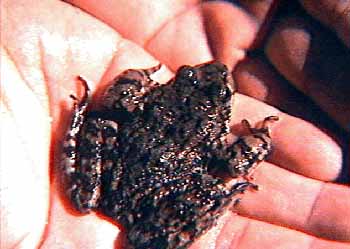
May 11, 1997:
I found out last week that the Forest Service had already flagged trees in Dark Canyon Campground for logging. After our recent investigation of the Black Mountain Group Camp logging, my anxiety over the latest proposed vegetation management treatment left me wondering what would we find when we visited the campground later today.

Dark Canyon happens to be one of my favorite locations in all of the San Jacinto Mountains. Three streams forming the headwaters of the San Jacinto River converge as a waterfall between groves of gigantic lichen encrusted Incense Cedar trees. Permanantly wet rock walls in this grotto are covered by an unbroken blanket of dark green mosses, Lady fern and Maidenhair fern, rare Lemon lilies, and Sierra columbine... while cold, uncontaminated water cascades over rocks and into clear pools at the base of the falls, to rapidly flow into the steep ravine forest of Dark Canyon, thus starting the descent of the North Fork of the San Jacinto River. Fortunately this beautiful place is forever protected within the Mount San Jacinto State Park Wilderness. But five miles down stream, Dark Canyon leaves wilderness and becomes National Forest property.
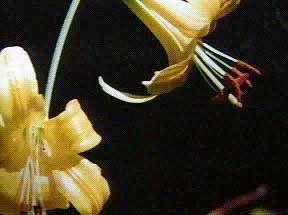
Lemon Lily, Lilium parryi
One hundred thousand years ago, as the southern California Mountains became climatically isolated from the Sierra Nevada ranges and the valleys between the ranges dried into deserts, the once widespread conifer forests condensed into separated island ecosystems. Rainfall in our mediterranean climate is unpredictable and during the past 10,000 years, the safest place for cold and wet loving species like ponderosa pine, sugar pine, incense cedar, white fir, lodgepole pine and limber pine were the highest elevations and steep narrow ravine canyons of the transeverse and peninsular mountains. The steepest canyons on the north and eastern escapments of the San Jacinto Mountains are too dry and disturbed by earthquake induced rock avalanches to support old growth relict conifer forests. But on the south and western slopes, the elevation gradient is not so severe yet the altitude sufficiently high to protect the forests that post-pleistocene climate changes cut off from the northern Sierra Nevada and eastern Rocky Mountain ranges. Isolated by climate and elevation, many southern California mixed conifer forests species have genetically diverged from the northern populations, and the most rapidly evolving plant and animal species have genetically drifted from their Sierran progenitors to now be considered by systematic biologists as distinctly unique species. The Lemon Lily, Tahquitz rock rose, Hidden Lake blue curls, Mountain Yellow-legged Frog, Southern Rubber Boa, Southern Spotted Owl; are examples of an entire assemblage of species that are genetically distinct and ecologically unique to the southern California conifer forests. Dark Canyon is an ecological refugia, a preserve for environmental conditions, habitats and biodiversity which would have gone extinct long ago if it were not for the characteristics of this fragile location.
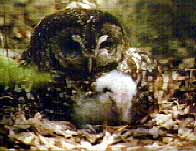
Southern Spotted Owl and her chick
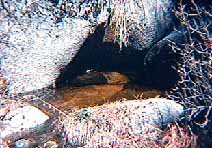
small protected pools like this along the San Jacinto River provide habitat for the rare Mountain Yellow-legged frog
The only population of Pacific Dogwood, Cornus nuttallii, in the San Jacinto Mountains occurs in Dark Canyon, while the largest of only two populations of Mountain Yellow-legged Frog,Rana muscosa, left in the San Jacinto Mountains inhabits the still cool waters of the North Fork San Jacinto River from below the Dark Canyon Campground upstream. According to the decision document I was holding in my hands, the U.S. Forest Service now has flagged about 100 trees in and surrounding the campground for cutting...the same management prescription that was applied to the Black Mountain Campgrounds. This campground is immediately adjacent to the San Jacinto River and the sensitive frog habitat. The forest understory has dozens of dogwood trees.
Professor David Wake, Director of the University of California, Berekely, Museum of Vertebrate Zoology shared with me many years ago the discovery of a rare hybrid between two species of Ensatina salamander, known only from Dark Canyon and several of the side tributaries. Salamanders are amphibians who are very sensitive to forest disturbance since their habitat consists of down and dead logs, hollow trees, and thick leaf litter...the stuff you find within un-logged old growth forests. Very few hybrids of these salamanders have been documented, and little knowledge exists concerning their reproduction, habitats, and survival.
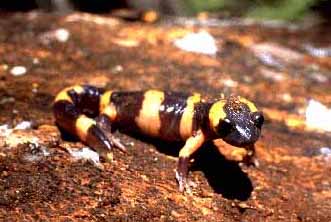
Ensatina eschscholtzii Klauberi occurs from Garner Valley north into Stawberry Valley to the North Fork of the San Jacinto River near Dark Canyon
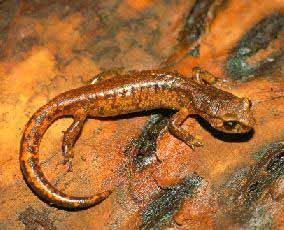
Ensatina eschscholtzii eschscholtzii, occurs from approximately Dark Canyon north towards the San Gorgonio Pass
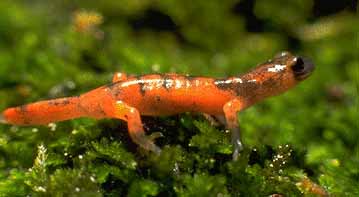
The hybrid between the two salamanders can be found in Dark Canyon
Scientists know very little about these sensitive animals, or the effect that selective logging might have on their survival, suffice to say that the movements of bulldozers and other heavy equipment would pose a major impact upon the salamander's habitat.
Walking around the Dark Canyon Campground and looking at the various trees that have blue spray paint marks tagging them for cutting, we have to wonder what kind of impact selective logging will have on the sensitive amphibians which live here. Years of car camping has changed the nature of the forest ecosystem within the campground. Soils are highly compressed, ground debris such as branches, logs and pine cones have been used for campfires, and very little understory vegetation has survived except for very hardy species. The trees that have been tagged are apparently confined to individual campsites and a few are leaning precariously, posing a potential hazard to campers and their vehicles. All of the trees are much younger and smaller than those cut up on Black Mountain. A close examination of individual trees show evidence of parasitic mistletoe, insect damage, and physical abuse by campers. Old stumps prove that trees have been cut within the campground over many years...this site would hardly qualify as a candidate for pristine wilderness!
What will be the impact of thinning the diseased trees from the Dark Canyon Campground? Based upon a initial walk around, our opinion was that there would be little impact to the wildlife that might live in the immediate vicinity. Camping at this location is very heavy from Memorial Day until Labor Day, so the impact of hundreds of people and their pets would be nearly as intense as the action of removing a hundred diseased and or poorly growing Ponderosa Pines, Incense Cedars and White Firs. Any soil disturbance should be minimized, and particularly any chance that sediments might run off into the San Jacinto River must be avoided. It is still very important that the U.S. Forest Service have a biologist present when the tree removal is conducted in order to monitor the logging and look for amphibians and other special species of concern.
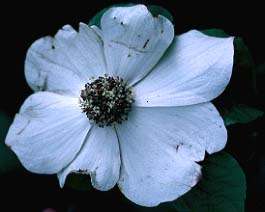
Pacific Dogwood, Cornus nuttalliii
Just as we were leaving the campground, there was an opportunity to take photographs of the wonderful dogwood trees in full bloom. In a small stream, just yards away from the San Jacinto River, sat a full grown Mountain Yellow-legged Frog... sunning itself on a granite boulder until our presence alerted her to possible danger and she jumped into the deep pool. A stone throws away is the Dark Canyon Campground, a unique refuge for escaping human city dwellers, and resident amphibians alike.
Amphibian References
Mountain Yellow-legged Frog
Bradford, D. F., D. M. Graber and F. Tabatabai. 1993. Isolation of remaining populations of the native frog, Rana muscosa, by introduced fishes in Sequoia and Kings and Canyon National Parks, California. Conserv. Biol. 7:882-888.
Bradford, D.F. 1991. Mass mortality and extinction in a high elevation population of Rana muscosa J. Herpetol. 25. 2. 174-177.
Bradford. D.F. 1983. Winterkill, oxygen relations, and energy metabolism of a submerged dormant amphibian, Rana muscosa. Ecology 64:1171-1183.
Coachella Valley Multiple Species Habitat Conservation Plan
MADERA COUNTY CALIFORNIA RED-LEGGED FROG RECOVERY PLANRana aurora draytonii,and YELLOW-LEGGED FROG CONSERVATION PROGRAMRana boylii and Rana muscosa,December 18, 1996
status of mtn yellow legged frog
Ensatina salamanders
University of California, Integrated Hardwood Range Management Program
Jackman, T. R., and D. B. Wake 1994. Evolutionary and historical analysis of protein variation in the blotched forms of salamanders of the Ensatina complex (Amphibia: Plethodontidae). Evolution 48:876-897.
Staub, Nancy L., Charles W. Brown, and David B. Wake. 1995. Patterns of growth and movements in a population of Ensatina eschscholtzii platensis (Caudata: Plethodontidae) in the Sierra Nevada, California. J. Herpetology 29:593-599.
Wake, D.B. and Kay P. Yanev. 1986. Geographic variation in a "ring species", the plethodontid salamander Ensatina eschscholtzii of North America. Evolution 40:702-715.
